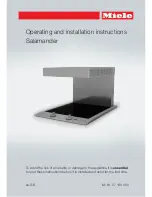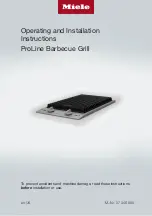
6
en
7. Operation
CAUTION:
In the event of the drill bit sticking, the tool
will pivot about its own axis.
Always use the tool with the side handle fitted and hold
it securely with both hands applying an opposing torque
so that the clutch releases in the event of the drill bit
sticking.
Use a vice or clamp to secure loose workpieces
.
7.1 Preparing the tool for use
7.1.1 Adjusting the depth gauge
1. Release the side handle clamping mechanism by
turning the handle in a counter-clockwise direction.
2. Pivot the side handle into the desired position.
3. Adjust the depth gauge to the desired drilling depth "X".
4. Tighten the side handle securely by turning the han-
dle in a clockwise direction.
7.1.2 Fitting the insert tool (TE-C)
1. Unplug the supply cord from the mains socket.
2. Check that the connection end of the insert tool is
clean and lightly greased. Clean it and grease it if
necessary.
3. Check that the sealing lip of the dust shield is clean
and in good condition. Clean the dust shield if nec-
essary or replace it if the sealing lip is damaged.
4. Push the connection end of the insert tool into the
chuck and, while applying slight pressure, rotate the
insert tool until it engages in the guide grooves.
5. Push the insert tool further into the chuck until it is
heard to engage.
6. Check that the insert tool has engaged correctly (pull
by hand).
7.1.3 Removing the insert tool
1. Unplug the supply cord from the mains socket.
2. Open the chuck by pulling back the locking sleeve.
3. Pull the insert tool out of the chuck.
7.1.4 Removing the chuck (TE-C und TE-T)
-NOTE-
Remove the depth gauge from the side handle in order
to avoid injury.
1. Unplug the supply cord from the mains socket.
2. Pull the retaining ring on the chuck toward the front
and hold it in this position.
3. Pull the chuck away from the tool toward the front.
-CAUTION-
G
The insert tool may become hot dur-
ing use.
G
There is a risk of burning the hands.
G
Wear protective gloves when chang-
ing insert tools.
6. Assembly
6.1 Fitting the side handle
1. Unplug the tool from the mains socket.
2. Release the side handle clamping band by turning
the handle in a counter-clockwise direction.
3. Fit the side handle clamping band over the chuck
and onto the cylindrical section at the front end of
the tool.
4. Pivot the side handle into the desired position.
5. Tighten the side handle securely to prevent inad-
vertent movement.
6.2 Use of extension cords
Use only extension cords of a type approved for the
application and with conductors of adequate cross sec-
tion. Failure to observe this point may cause the tool
to lose power and the extension cord may overheat.
Check the extension cord for damage at regular inter-
vals. Replace damaged extension cords.
Recommended minimum conductor cross section and
max. extension cord lengths:
Mains voltage Conductor cross section
AWG
1.5 mm
2
2.0 mm
2
2.5 mm
2
3.5 mm
2
14
12
100 V
–
30 m
–
50 m
–
–
110–120 V
20 m
30 m
40 m
–
75 ft 125 ft
220–240 V
50 m
–
100 m
–
–
–
Do not use extension cords with 1.25 mm
2
or 16 AWG conductor cross sections.
Use of extension cords outdoors
When working outdoors use only extension cords that are
correspondingly marked and approved for outdoor use.
6.3 Use of a generator or transformer
This tool may be powered by a generator or transformer
which fulfils the following conditions:
– AC voltage, output power at least 2600 W.
– The operating voltage must be 5 % and
–15 % of the rated voltage at all times.
– Frequency range 50–60 Hz, never above 65 Hz.
– Automatic voltage regulation with starting boost.
Never operate other tools or appliances from the gen-
erator or transformer at the same time. Switching other
tools or appliances on and off may cause undervolt-
age and/or overvoltage peaks, resulting in damage to
the electric tool.
Printed: 07.07.2013 | Doc-Nr: PUB / 5070797 / 000 / 00




































